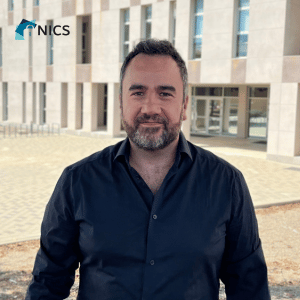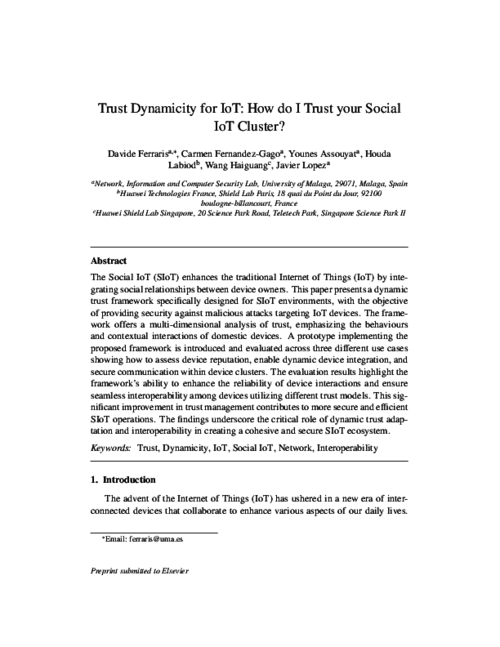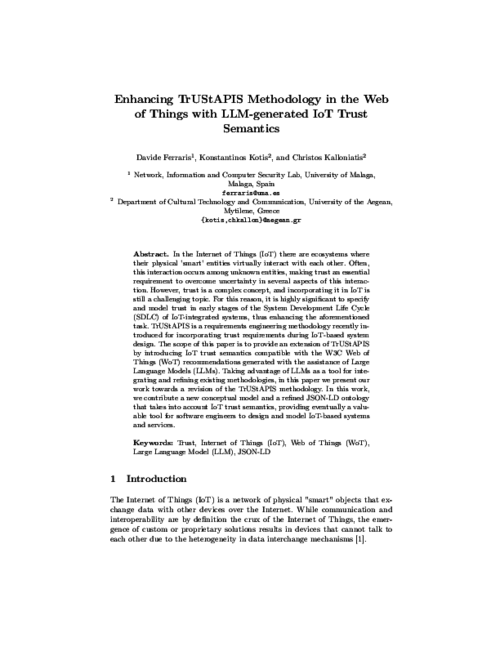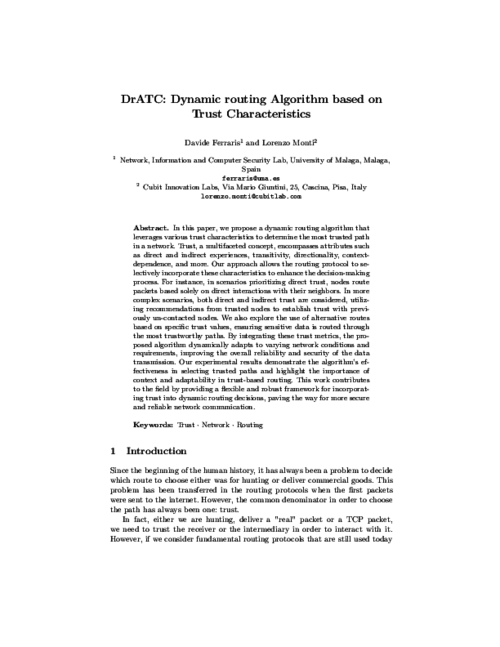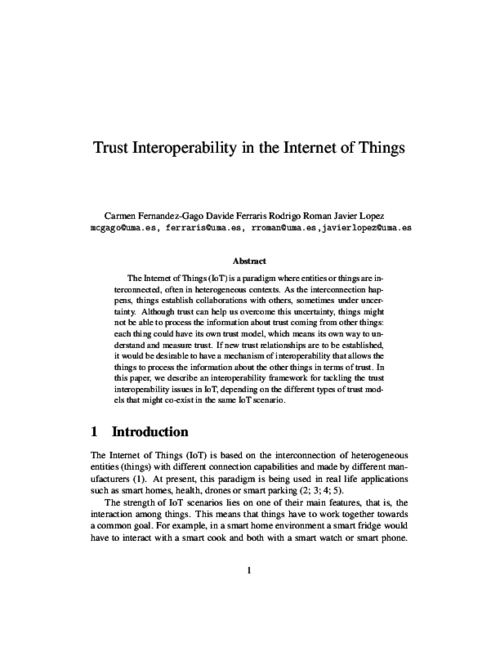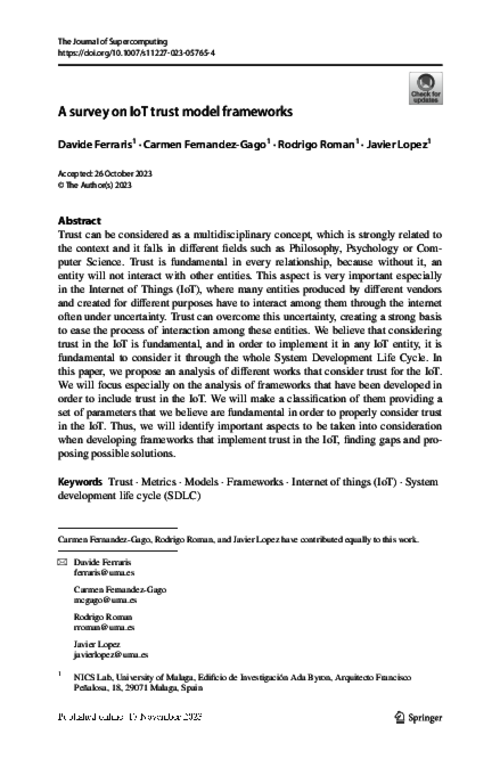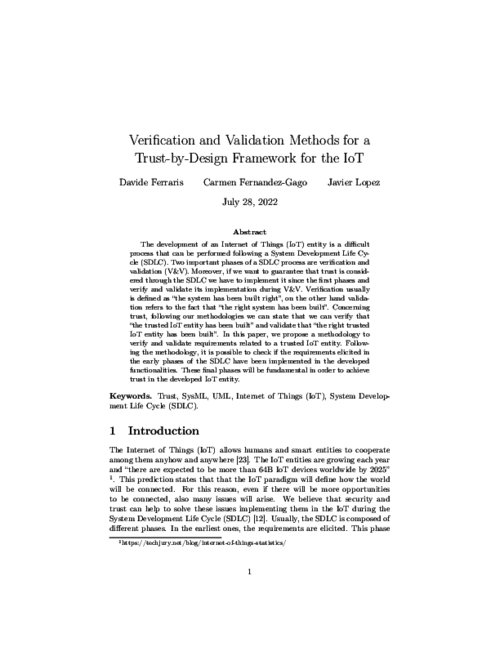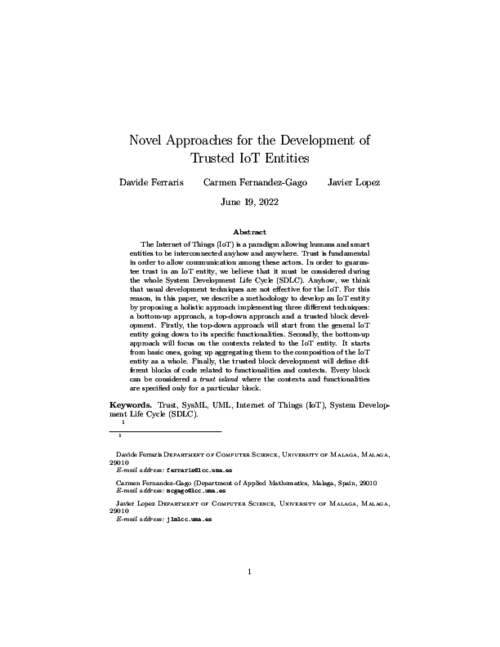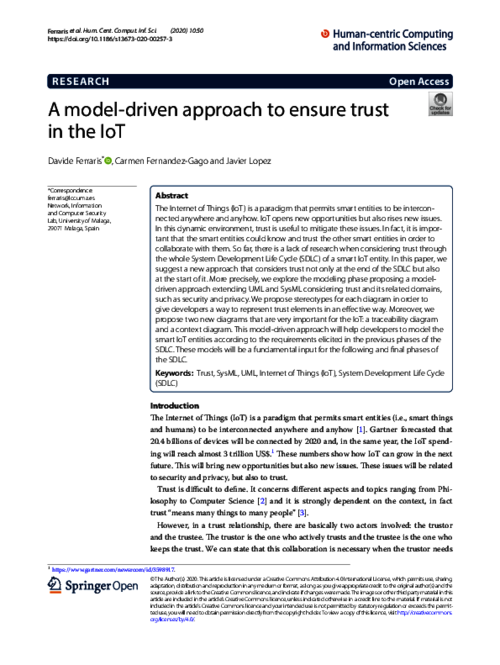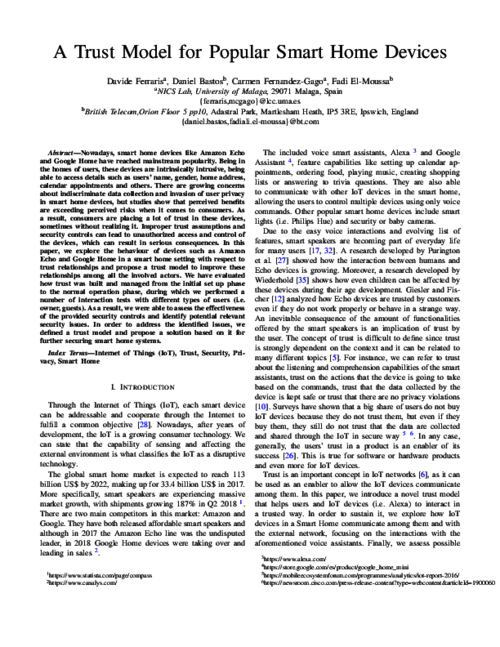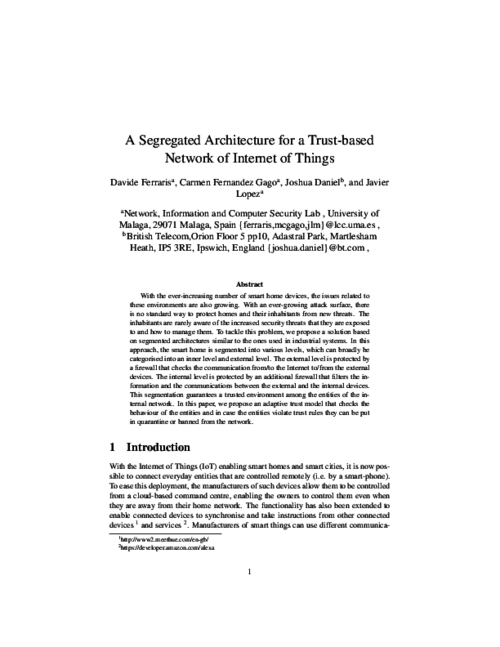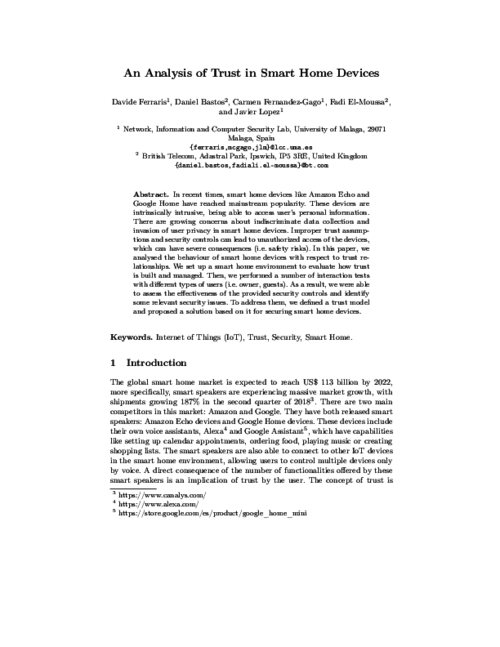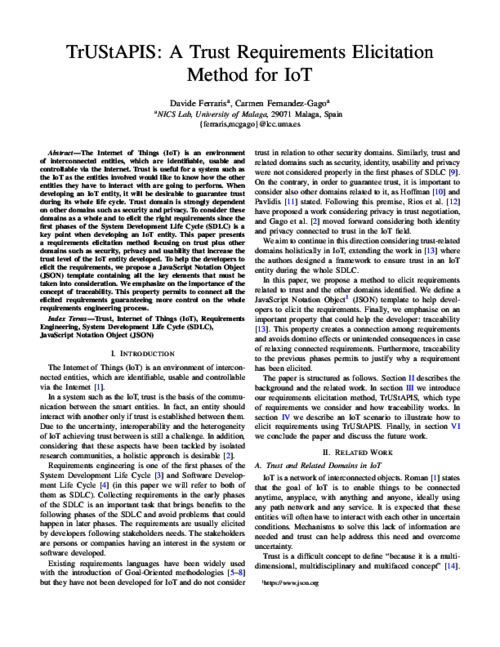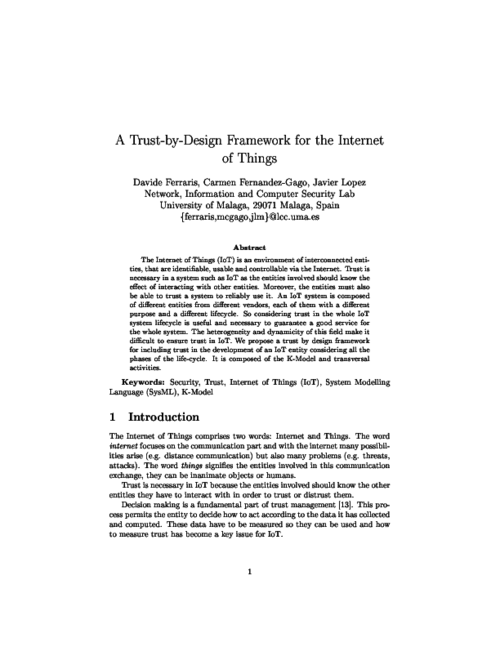Davide Ferraris
Assistant professor
Edificio de Investigación Ada Byron
C/ Arquitecto Francisco Peñalosa, nº 18
Ampliación Campus de Teatinos. Universidad de Málaga
29071 Málaga (Spain)
Phone: +34 951 952 939
E-mail: ferraris@uma.es
Domain of interest and research
- Trust
- Internet of Things
- System Engineering
- Blockchain Technologies
Current research
- Trust Metrics for the Internet of Things
Education
- Bachelor Degree in Computer Science Engineering at Univerisity of Genoa with the Thesis: “Study, realization and integration of intelligent devices deployed for ambient intelligence applications”
- Master Degree in Computer Science Engineering at Univerisity of Genoa with Thesis: “Analysis and applications of tools for penetration testing platform” Joomla!” ” in collaboration with University of Genoa and Liguria Digitale SPA.
- Professional Master’s Programmes in System Engineering acquired with Thesis: “Analysis, development and security of the internal system for Drydock management software.”
- Title of Expert in Blockchain Technologies at University of Malaga
- PhD in Computer Security at University of Malaga with Thesis: “A Trust-by-Design Framework for the Internet of Things“
Publications
Davide Ferraris, Carmen Fernandez-Gago, Younes Assouyat, Houda Labiod, Wang Haiguang, Javier Lopez
Trust dynamicity for IoT: How do i trust your social IoT cluster? Journal Article
In: Internet of Things, vol. 30, 2025.
@article{ferraris2025iot,
title = {Trust dynamicity for IoT: How do i trust your social IoT cluster?},
author = {Davide Ferraris and Carmen Fernandez-Gago and Younes Assouyat and Houda Labiod and Wang Haiguang and Javier Lopez},
editor = {Elsevier},
doi = {10.1016/j.iot.2025.101529},
year = {2025},
date = {2025-03-01},
urldate = {2025-03-01},
journal = {Internet of Things},
volume = {30},
abstract = {The Social IoT (SIoT) enhances the traditional Internet of Things (IoT) by integrating social relationships between device owners. This paper presents a dynamic trust framework specifically designed for SIoT environments, with the objective of providing security against malicious attacks targeting IoT devices. The framework offers a multi-dimensional analysis of trust, emphasizing the behaviours and contextual interactions of domestic devices. A prototype implementing the proposed framework is introduced and evaluated across three different use cases showing how to assess device reputation, enable dynamic device integration, and secure communication within device clusters. The evaluation results highlight the framework’s ability to enhance the reliability of device interactions and ensure seamless interoperability among devices utilizing different trust models. This significant improvement in trust management contributes to more secure and efficient SIoT operations. The findings underscore the critical role of dynamic trust adaptation and interoperability in creating a cohesive and secure SIoT ecosystem.},
keywords = {},
pubstate = {published},
tppubtype = {article}
}
Davide Ferraris, Konstantinos Kotis, Christos Kalloniatis
Enhancing TrUStAPIS Methodology in the Web of Things with LLM-generated IoT Trust Semantics Proceedings Article Forthcoming
In: 26th International Conference on Information and Communications Security (ICICS 2024), Springer, Mytilene, Lesvos, Greece, Forthcoming.
BibTeX | Links:
@inproceedings{ferraris2024ici,
title = {Enhancing TrUStAPIS Methodology in the Web of Things with LLM-generated IoT Trust Semantics},
author = {Davide Ferraris and Konstantinos Kotis and Christos Kalloniatis},
url = {/wp-content/papers/ferraris2024ici.pdf},
year = {2024},
date = {2024-12-31},
urldate = {2024-12-31},
booktitle = {26th International Conference on Information and Communications Security (ICICS 2024)},
publisher = {Springer},
address = {Mytilene, Lesvos, Greece},
keywords = {},
pubstate = {forthcoming},
tppubtype = {inproceedings}
}
Davide Ferraris, Lorenzo Monti
DrATC: Dynamic routing Algorithm based on Trust Characteristics Proceedings Article Forthcoming
In: The 20th International Workshop on Security and Trust Management (STM 2024), Springer, Bydgoszcz, Poland, Forthcoming.
BibTeX | Links:
@inproceedings{ferraris2024stm,
title = {DrATC: Dynamic routing Algorithm based on Trust Characteristics},
author = {Davide Ferraris and Lorenzo Monti},
url = {/wp-content/papers/ferraris2024stm.pdf},
year = {2024},
date = {2024-12-31},
urldate = {2024-12-31},
booktitle = {The 20th International Workshop on Security and Trust Management (STM 2024)},
publisher = {Springer},
address = {Bydgoszcz, Poland},
keywords = {},
pubstate = {forthcoming},
tppubtype = {inproceedings}
}
Carmen Fernandez-Gago, Davide Ferraris, Rodrigo Roman, Javier Lopez
Trust interoperability in the Internet of Things Journal Article
In: Internet of Things, vol. 26, 2024.
@article{FerIoT24,
title = {Trust interoperability in the Internet of Things},
author = {Carmen Fernandez-Gago and Davide Ferraris and Rodrigo Roman and Javier Lopez},
url = {/wp-content/papers/FerIoT24.pdf},
doi = {https://doi.org/10.1016/j.iot.2024.101226},
year = {2024},
date = {2024-07-31},
urldate = {2024-07-31},
journal = {Internet of Things},
volume = {26},
abstract = {The Internet of Things (IoT) is a paradigm where entities or things are interconnected, often in heterogeneous contexts. As the interconnection happens, things establish collaborations with others, sometimes under uncertainty. Although trust can help us overcome this uncertainty, things might not be able to process the information about trust coming from other things: each thing could have its own trust model, which means its own way to understand and measure trust. If new trust relationships are to be established, it would be desirable to have a mechanism of interoperability that allows the things to process the information about the other things in terms of trust. In this paper, we describe an interoperability framework for tackling the trust interoperability issues in IoT, depending on the different types of trust models that might co-exist in the same IoT scenario.},
keywords = {},
pubstate = {published},
tppubtype = {article}
}
Davide Ferraris, Carmen Fernandez-Gago, Rodrigo Roman, Javier Lopez
A Survey on IoT Trust Model Frameworks Journal Article
In: The Journal of Supercomputing, vol. 80, pp. 8259–8296, 2023.
@article{surveyIoTrust2023,
title = {A Survey on IoT Trust Model Frameworks},
author = {Davide Ferraris and Carmen Fernandez-Gago and Rodrigo Roman and Javier Lopez},
url = {/wp-content/papers/surveyIoTrust2023.pdf},
doi = {10.1007/s11227-023-05765-4},
year = {2023},
date = {2023-11-17},
urldate = {2023-11-17},
journal = {The Journal of Supercomputing},
volume = {80},
pages = {8259\textendash8296},
abstract = {Trust can be considered as a multidisciplinary concept, which is strongly related to the context and it falls in different fields such as Philosophy, Psychology or Computer Science. Trust is fundamental in every relationship, because without it, an entity will not interact with other entities. This aspect is very important especially in the Internet of Things (IoT), where many entities produced by different vendors and created for different purposes have to interact among them through the internet often under uncertainty. Trust can overcome this uncertainty, creating a strong basis to ease the process of interaction among these entities. We believe that considering trust in the IoT is fundamental, and in order to implement it in any IoT entity, it is fundamental to consider it through the whole System Development Life Cycle. In this paper, we propose an analysis of different works that consider trust for the IoT. We will focus especially on the analysis of frameworks that have been developed in order to include trust in the IoT. We will make a classification of them providing a set of parameters that we believe are fundamental in order to properly consider trust in the IoT. Thus, we will identify important aspects to be taken into consideration when developing frameworks that implement trust in the IoT, finding gaps and proposing possible solutions.},
keywords = {},
pubstate = {published},
tppubtype = {article}
}
Davide Ferraris, Carmen Fernandez-Gago, Javier Lopez
POM: A Trust-based AHP-like Methodology to Solve Conflict Requirements for the IoT Book Section
In: Collaborative Approaches for Cyber Security in Cyber-Physical Systems, pp. 145-170, Springer, 2023, ISSN: 1613-5113.
BibTeX | Links:
@incollection{2013,
title = {POM: A Trust-based AHP-like Methodology to Solve Conflict Requirements for the IoT},
author = {Davide Ferraris and Carmen Fernandez-Gago and Javier Lopez},
url = {/wp-content/papers/2013.pdf
https://link.springer.com/chapter/10.1007/978-3-031-16088-2_7},
doi = {https://doi.org/10.1007/978-3-031-16088-2_7},
issn = {1613-5113},
year = {2023},
date = {2023-01-01},
urldate = {2023-01-01},
booktitle = {Collaborative Approaches for Cyber Security in Cyber-Physical Systems},
pages = {145-170},
publisher = {Springer},
organization = {Springer},
series = {Part of the Advanced Sciences and Technologies for Security Applications book series (ASTSA)},
keywords = {},
pubstate = {published},
tppubtype = {incollection}
}
Davide Ferraris, Carmen Fernandez-Gago, Javier Lopez
Verification and Validation Methods for a Trust-by-Design Framework for the IoT Proceedings Article
In: 36th Annual IFIP WG 11.3 Conference on Data and Applications Security and Privacy (DBSec’22), pp. 183-194, Springer Springer, Newark, NJ, USA, 2022, ISBN: 978-3-031-10683-5.
BibTeX | Links:
@inproceedings{1981,
title = {Verification and Validation Methods for a Trust-by-Design Framework for the IoT},
author = {Davide Ferraris and Carmen Fernandez-Gago and Javier Lopez},
url = {/wp-content/papers/1981.pdf
https://link.springer.com/chapter/10.1007/978-3-031-10684-2_11, },
doi = {10.1007/978-3-031-10684-2_11},
isbn = {978-3-031-10683-5},
year = {2022},
date = {2022-07-01},
urldate = {2022-07-01},
booktitle = {36th Annual IFIP WG 11.3 Conference on Data and Applications Security and Privacy (DBSec’22)},
volume = {13383},
pages = {183-194},
publisher = {Springer},
address = {Newark, NJ, USA},
organization = {Springer},
keywords = {},
pubstate = {published},
tppubtype = {inproceedings}
}
Davide Ferraris, Carmen Fernandez-Gago, Javier Lopez
Novel Approaches for the Development of Trusted IoT Entities Proceedings Article
In: 37th International Conference on ICT Systems Security and Privacy Protection – IFIP SEC 2022, pp. 215-230, Springer Springer, Copenhagen, 2022, ISSN: 1868-4238.
BibTeX | Links:
@inproceedings{1980,
title = {Novel Approaches for the Development of Trusted IoT Entities},
author = {Davide Ferraris and Carmen Fernandez-Gago and Javier Lopez},
url = {/wp-content/papers/1980.pdf
https://link.springer.com/content/pdf/10.1007%2F978-3-031-06975-8_13, },
doi = {10.1007/978-3-031-06975-8},
issn = {1868-4238},
year = {2022},
date = {2022-06-01},
urldate = {2022-06-01},
booktitle = {37th International Conference on ICT Systems Security and Privacy Protection \textendash IFIP SEC 2022},
pages = {215-230},
publisher = {Springer},
address = {Copenhagen},
organization = {Springer},
keywords = {},
pubstate = {published},
tppubtype = {inproceedings}
}
Davide Ferraris, Carmen Fernandez-Gago, Javier Lopez
A model-driven approach to ensure trust in the IoT Journal Article
In: Human-centric Computing and Information Sciences, vol. 10, no. 50, 2020, ISSN: 2192-1962.
@article{ferraris2020b,
title = {A model-driven approach to ensure trust in the IoT},
author = {Davide Ferraris and Carmen Fernandez-Gago and Javier Lopez},
url = {/wp-content/papers/ferraris2020b.pdf},
doi = {10.1186/s13673-020-00257-3},
issn = {2192-1962},
year = {2020},
date = {2020-12-01},
urldate = {2020-12-01},
journal = {Human-centric Computing and Information Sciences},
volume = {10},
number = {50},
publisher = {Springer},
abstract = {The Internet of Things (IoT) is a paradigm that permits smart entities to be interconnected anywhere and anyhow. IoT opens new opportunities but also rises new issues.
In this dynamic environment, trust is useful to mitigate these issues. In fact, it is important that the smart entities could know and trust the other smart entities in order to collaborate with them.
So far, there is a lack of research when considering trust through the whole System Development Life Cycle (SDLC) of a smart IoT entity.
In this paper, we suggest a new approach that considers trust not only at the end of the SDLC but also at the start of it. More precisely, we explore the modeling phase proposing a model-driven approach extending UML and SysML considering trust and its related domains, such as security and privacy.
We propose stereotypes for each diagram in order to give developers a way to represent trust elements in an effective way.
Moreover, we propose two new diagrams that are very important for the IoT: a traceability diagram and a context diagram.
This model-driven approach will help developers to model the smart IoT entities according to the requirements elicited in the previous phases of the SDLC.
These models will be a fundamental input for the following and final phases of the SDLC.},
keywords = {},
pubstate = {published},
tppubtype = {article}
}
In this dynamic environment, trust is useful to mitigate these issues. In fact, it is important that the smart entities could know and trust the other smart entities in order to collaborate with them.
So far, there is a lack of research when considering trust through the whole System Development Life Cycle (SDLC) of a smart IoT entity.
In this paper, we suggest a new approach that considers trust not only at the end of the SDLC but also at the start of it. More precisely, we explore the modeling phase proposing a model-driven approach extending UML and SysML considering trust and its related domains, such as security and privacy.
We propose stereotypes for each diagram in order to give developers a way to represent trust elements in an effective way.
Moreover, we propose two new diagrams that are very important for the IoT: a traceability diagram and a context diagram.
This model-driven approach will help developers to model the smart IoT entities according to the requirements elicited in the previous phases of the SDLC.
These models will be a fundamental input for the following and final phases of the SDLC.
Davide Ferraris, Daniel Bastos, Carmen Fernandez-Gago, Fadi El-Moussa
A Trust Model for Popular Smart Home Devices Journal Article
In: International Journal of Information Security, 2020, ISSN: 1615-5262.
@article{ferraris2020,
title = {A Trust Model for Popular Smart Home Devices},
author = {Davide Ferraris and Daniel Bastos and Carmen Fernandez-Gago and Fadi El-Moussa},
url = {/wp-content/papers/ferraris2020.pdf
https://link.springer.com/article/10.1007/s10207-020-00519-2},
doi = {10.1007/s10207-020-00519-2},
issn = {1615-5262},
year = {2020},
date = {2020-01-01},
urldate = {2020-01-01},
journal = {International Journal of Information Security},
publisher = {Springer},
abstract = {Nowadays, smart home devices like Amazon Echo and Google Home have reached mainstream popularity.
Being in the homes of users, these devices are intrinsically intrusive, being able to access details such as users’ name, gender, home address, calendar appointments and others.
There are growing concerns about indiscriminate data collection and invasion of user privacy in smart home devices, but studies show that perceived benefits are exceeding perceived risks when it comes to consumers.
As a result, consumers are placing a lot of trust in these devices, sometimes without realizing it.
Improper trust assumptions and security controls can lead to unauthorized access and control of the devices, which can result in serious consequences.
In this paper, we explore the behaviour of devices such as Amazon Echo and Google Home in a smart home setting with respect to trust relationships and propose a trust model to improve these relationships among all the involved actors.
We have evaluated how trust was built and managed from the initial set up phase to the normal operation phase, during which we performed a number of interaction tests with different types of users (i.e. owner, guests).
As a result, we were able to assess the effectiveness of the provided security controls and identify potential relevant security issues. In order to address the identified issues, we defined a trust model and propose a solution based on it for further securing smart home systems.},
keywords = {},
pubstate = {published},
tppubtype = {article}
}
Being in the homes of users, these devices are intrinsically intrusive, being able to access details such as users’ name, gender, home address, calendar appointments and others.
There are growing concerns about indiscriminate data collection and invasion of user privacy in smart home devices, but studies show that perceived benefits are exceeding perceived risks when it comes to consumers.
As a result, consumers are placing a lot of trust in these devices, sometimes without realizing it.
Improper trust assumptions and security controls can lead to unauthorized access and control of the devices, which can result in serious consequences.
In this paper, we explore the behaviour of devices such as Amazon Echo and Google Home in a smart home setting with respect to trust relationships and propose a trust model to improve these relationships among all the involved actors.
We have evaluated how trust was built and managed from the initial set up phase to the normal operation phase, during which we performed a number of interaction tests with different types of users (i.e. owner, guests).
As a result, we were able to assess the effectiveness of the provided security controls and identify potential relevant security issues. In order to address the identified issues, we defined a trust model and propose a solution based on it for further securing smart home systems.
Davide Ferraris, Carmen Fernandez-Gago, Joshua Daniel, Javier Lopez
A Segregated Architecture for a Trust-based Network of Internet of Things Proceedings Article
In: IEEE Consumer Communications & Networking Conference 2019, IEEE IEEE, Las Vegas (USA), 2019.
@inproceedings{1780,
title = {A Segregated Architecture for a Trust-based Network of Internet of Things},
author = {Davide Ferraris and Carmen Fernandez-Gago and Joshua Daniel and Javier Lopez},
url = {/wp-content/papers/1780.pdf
https://ieeexplore.ieee.org/document/8651703},
doi = {10.1109/CCNC.2019.8651703},
year = {2019},
date = {2019-03-01},
urldate = {2019-03-01},
booktitle = {IEEE Consumer Communications \& Networking Conference 2019},
publisher = {IEEE},
address = {Las Vegas (USA)},
organization = {IEEE},
abstract = {With the ever-increasing number of smart home devices, the issues related to these environments are also growing. With an ever-growing attack surface, there is no standard way to protect homes and their inhabitants from new threats. The inhabitants are rarely aware of the increased security threats that they are exposed to and how to manage them. To tackle this problem, we propose a solution based on segmented architectures similar to the ones used in industrial systems. In this approach, the smart home is segmented into various levels, which can broadly be categorised into an inner level and external level. The external level is protected by a firewall that checks the communication from/to the Internet to/from the external devices. The internal level is protected by an additional firewall that filters the information and the communications between the external and the internal devices. This segmentation guarantees a trusted environment between the entities belonging to the internal network. In this paper, we propose an adaptive trust model that checks the behaviour of the entities and, through this model, in case the entities violate trust rules they can be put in quarantine or banned from the network.},
keywords = {},
pubstate = {published},
tppubtype = {inproceedings}
}
Davide Ferraris, Daniel Bastos, Carmen Fernandez-Gago, Fadi El-Moussa, Javier Lopez
An Analysis of Trust in Smart Home Devices Proceedings Article
In: The 20th World Conference on Information Security Applications: WISA-Workshop 2019, Springer Springer, Jeju Island, Korea, 2019.
@inproceedings{1814,
title = {An Analysis of Trust in Smart Home Devices},
author = {Davide Ferraris and Daniel Bastos and Carmen Fernandez-Gago and Fadi El-Moussa and Javier Lopez},
url = {/wp-content/papers/1814.pdf},
year = {2019},
date = {2019-01-01},
urldate = {2019-01-01},
booktitle = {The 20th World Conference on Information Security Applications: WISA-Workshop 2019},
publisher = {Springer},
address = {Jeju Island, Korea},
organization = {Springer},
abstract = {In recent times, smart home devices like Amazon Echo and Google Home have reached mainstream popularity. These devices are intrinsically intrusive, being able to access user’s personal information. There are growing concerns about indiscriminate data collection and invasion of user privacy in smart home devices. Improper trust assumptions and security controls can lead to unauthorized access of the devices, which can have severe consequences (i.e. safety risks). In this paper, we analysed the behaviour of smart home devices with respect to trust relationships. We set up a smart home environment to evaluate how trust is built and managed. Then, we performed a number of interaction tests with different types of users (i.e. owner, guests). As a result, we were able to assess the effectiveness of the provided security controls and identify some relevant security issues. To address them, we defined a trust model and proposed a solution based on it for securing smart home devices.},
keywords = {},
pubstate = {published},
tppubtype = {inproceedings}
}
Davide Ferraris, Carmen Fernandez-Gago
TrUStAPIS: A Trust Requirements Elicitation Method for IoT Journal Article
In: International Journal of Information Security, pp. 111-127, 2019, ISSN: 1615-5262.
@article{ferraris2019,
title = {TrUStAPIS: A Trust Requirements Elicitation Method for IoT},
author = {Davide Ferraris and Carmen Fernandez-Gago},
url = {/wp-content/papers/ferraris2019.pdf
https://link.springer.com/article/10.1007%2Fs10207-019-00438-x},
doi = {10.1007/s10207-019-00438-x},
issn = {1615-5262},
year = {2019},
date = {2019-01-01},
urldate = {2019-01-01},
journal = {International Journal of Information Security},
pages = {111-127},
publisher = {Springer},
abstract = {The Internet of Things (IoT) is an environment of interconnected entities, which are identifiable, usable and controllable via the Internet. Trust is useful for a system such as the IoT as the entities involved would like to know how the other entities they have to interact with are going to perform.
When developing an IoT entity, it will be desirable to guarantee trust during its whole life cycle. Trust domain is strongly dependent on other domains such as security and privacy.
To consider these domains as a whole and to elicit the right requirements since the first phases of the System Development Life Cycle (SDLC) is a key point when developing an IoT entity.
This paper presents a requirements elicitation method focusing on trust plus other domains such as security, privacy and usability that increase the trust level of the IoT entity developed. To help the developers to elicit the requirements, we propose a JavaScript Notation Object (JSON) template containing all the key elements that must be taken into consideration.
We emphasize on the importance of the concept of traceability. This property permits to connect all the elicited requirements guaranteeing more control on the whole requirements engineering process.},
keywords = {},
pubstate = {published},
tppubtype = {article}
}
When developing an IoT entity, it will be desirable to guarantee trust during its whole life cycle. Trust domain is strongly dependent on other domains such as security and privacy.
To consider these domains as a whole and to elicit the right requirements since the first phases of the System Development Life Cycle (SDLC) is a key point when developing an IoT entity.
This paper presents a requirements elicitation method focusing on trust plus other domains such as security, privacy and usability that increase the trust level of the IoT entity developed. To help the developers to elicit the requirements, we propose a JavaScript Notation Object (JSON) template containing all the key elements that must be taken into consideration.
We emphasize on the importance of the concept of traceability. This property permits to connect all the elicited requirements guaranteeing more control on the whole requirements engineering process.
Davide Ferraris, Carmen Fernandez-Gago, Javier Lopez
A Trust-by-Design Framework for the Internet of Things Proceedings Article
In: 2018 9th IFIP International Conference on New Technologies Mobility and Security (NTMS), IEEE IEEE, Paris, 2018, ISSN: 2157-4960.
@inproceedings{1684,
title = {A Trust-by-Design Framework for the Internet of Things},
author = {Davide Ferraris and Carmen Fernandez-Gago and Javier Lopez},
url = {/wp-content/papers/1684.pdf
http://ieeexplore.ieee.org/document/8328674/},
doi = {10.1109/NTMS.2018.8328674},
issn = {2157-4960},
year = {2018},
date = {2018-04-01},
urldate = {2018-04-01},
booktitle = {2018 9th IFIP International Conference on New Technologies Mobility and Security (NTMS)},
publisher = {IEEE},
address = {Paris},
organization = {IEEE},
abstract = {The Internet of Things (IoT) is an environment of interconnected entities, that are identifiable, usable and controllable via the Internet. Trust is necessary in a system such as IoT as the entities involved should know the effect of interacting with other entities. Moreover, the entities must also be able to trust a system to reliably use it. An IoT system is composed of different entities from different vendors, each of them with a different purpose and a different lifecycle. So considering trust in the whole IoT system lifecycle is useful and necessary to guarantee a good service for the whole system. The heterogeneity and dynamicity of this field make it difficult to ensure trust in IoT. We propose a trust by design framework for including trust in the development of an IoT entity considering all the phases of the life-cycle. It is composed of the K-Model and transversal activities.},
keywords = {},
pubstate = {published},
tppubtype = {inproceedings}
}
Previous Publications…
- P.A. Zapata-Ramírez, G. Landi, M. Palma, D. Ferraris, M. Ponti, U. Pantaleo, M. Meidinger, V. Markantonatou, S. Coppo, C. Cerrano. Conference Paper: “The visualization of geographical dataset on mobile devices using Augmented Reality application based: a case of study from Liguria Region”
- M Palma · U Pantaleo · D Ferraris · D Scaradozzi · C Cerrano. Presentation: Category: New technologies & methods for scientific divers to improve underwater research. Underwater photomosaics: New tools fos faster benthic assessments and long term monitoring
- Patent Submitted: “ Method and device of an object path tracking” n° 102015000029875 (UB2015A001810) Ferraris Davide, Palma Marco, Pantaleo Ubaldo, Cerrano Carlo, Chiantore Maria Chiara
EUROPEAN Projects
Development
- Development of an Android Application for underwater research: https://play.google.com/store/apps/details?id=com.ubica.reefcheckmed&hl=it
Memberships
- IEEE membership
- INCOSE
Secondments
- Cubit Lab, Pisa (Italy) July/August 2023
- NeuroSoft, Athens (Greece) September/December 2019
- University of Trento (Italy) Mid January/Mid February 2019
- British Telecom, Ipswich (UK) May/July 2017 and May/July 2018
Attended Conferences, Courses and Seminars
- DBSEC 2022: Conference on Data and Applications Security and Privacy (Newark, USA) from 18th to 20th of July 2022
- IFIP SEC 2022: Information Security Conference & Privacy Conference (Copenhagen, Denmark) from 13th to 15th of June 2022
- Researcher Nights 2021 (Malaga, Spain)
- Seminar on Trust and IoT (Samos, Greece)
- Seminar on Trust in the IoT organized by the Privacy Engineering and Social Informatics Laboratory (PrivaSI Lab) (Lesvos, Greece)
- Researcher Nights 2019 (Athens, Greece)
- 19th International School on Foundations of Security Analysis and Design (FOSAD) (Bertinoro, Italy) from the 26th to the 30th of August 2019
- WISA2019: The 20th World Conference on Information Security Applications (Jeju, South Korea) from 21st to 24th of August 2019
- Seminar on Trust in the IoT at FBK (Trento, Italy)
- A Pint of Science 2019 (Malaga, Spain)
- NECS PhD Winter School 2019 in Fai della Paganella (TN, Italy) from 18th to 22th of February 2019
- CCNC2019: IEEE Consumer Communications & Networking Conference (Las Vegas, USA) from the 11th to the 14th of January 2019
- CyberCamp 2018 (Malaga, Spain) from the 29th of November to the 2nd of December 2018
- Festival of Science 2018 (Genova, Italy) from 25th of October to the 4th of November 2018
- Coffee with Science 2018 (Malaga, Spain)
- CyberSecurity Day 2018 (Pisa, Italy)
- Training course of Project Management and IPR at CNR (Pisa, Italy)
- Researcher Nights 2018 (Malaga, Spain)
- ESORICS 2018: European Symposium on Research in Computer Security (Barcelona, Spain) from the 3rd to the 7th of September 2018
- 18th International School on Foundations of Security Analysis and Design (FOSAD) (Bertinoro, Italy) from the 27th to the 31st of August 2018
- Intensive Programme on Information and Communications Security – IPICS2018 (Lesvos, Greece) from the 2nd to the 13th of July 2018
- Seminar at Samovar laboratory (Paris, France)
- NTMS 2018: IEEE New Technologies, Mobility and Security (Paris, France) from the 26th to the 28th of February 2018
- NECS PhD Winter School 2018 in Trento (TN, Italy) from the 12th to the 16th of February 2018
- El Futuro de la Tecnologias Wireless, Seminar by Rohde & Schwarz (Malaga)
- Coffee with Science 2017 (Malaga, Spain)
- Researcher Nights 2017 (Malaga, Spain)
- European Cyber Security Challenge 2017 (Malaga, Spain) from the 31st of October to the 1st of November 2017
- ESORICS 2017: European Symposium on Research in Computer Security (Oslo, Norway) from 11th to 15th of September 2017
- 17th International School on Foundations of Security Analysis and Design (FOSAD) (Bertinoro, Italy) from 28th of August to 2nd of September 2017
- IFIP SEC 2017: Information Security Conference & Privacy Conference (Rome, Italy) from 29th to 31st of May 2017
- NECS PhD Winter School 2017 in Fai della Paganella (TN, Italy) from 7th to 10th of February 2017
- Augmented Reality studies, participation at Augmented World Expo 2014 in Santa Clara (California, USA) from 27th to 29th of May 2014
Dissemination activities
- European Researcher’s Night 2019 (Athens, Greece) the 27th of September 2019
- Tertulias Uciencia (A Pint of Science) 2019 (Malaga, Spain) the 7th of March 2019
- Coffee with Science 2018 (Malaga, Spain) the 20th of November 2018
- Genoa International Science Festival 2018 (Genova, Italy) from the 25th of October to the 4th of November 2018
- European Researcher’s Night 2018(Malaga, Spain) the 28th of September 2018
- Open PhD Forum @FOSAD2018 (Bertinoro, Italy) the 29th of August 2018
- Coffee with Science 2017 (Malaga, Spain) the 14th of November 2017
- European Researcher’s Night 2017 (Malaga, Spain) the 29th of September 2017
- NeCS Program PhD Forum @IFIP SEC 2017 (Rome, Italy) the 29th of May 2017


